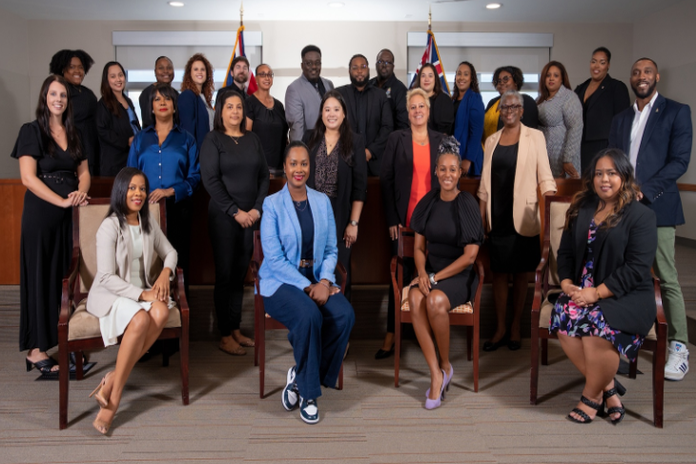By Department of Communications
Effective communication is a cornerstone of successful governance. It enhances public policies, engages communities, and cultivates a well-informed citizenry.
Our ongoing commitment to enhancing government communications is evident in the strategic evolution and structural enhancements we have implemented. These changes mark a significant stride towards governance that is more transparent, efficient, and responsive, ensuring that as our society evolves, our methods of communication are not only keeping pace but setting new standards in governmental interaction.
The legacy of GIS
The phrase “Let the record show” is often used when the past is invoked to justify or contextualise the present. For over 50 years, Government Information Services (GIS), has served the country as the official custodian of government records, capturing pivotal national developments through various media formats including print, photography and video.
Starting with pioneers like Olive Miller, GIS has been instrumental in chronicling our national growth, from the emergence of our economic pillars to the development that has forever changed the landscape of all three Cayman Islands.
As the need for sophisticated and accessible government information expanded, so did GIS. It evolved by embracing a broader array of specialised professionals dedicated to meeting the evolving needs of the public.
Strategic transformation into the department of communications
This growth set the stage for a significant transformation, aligning with the Civil Service Five-Year Strategic Plan of 2017. A central tenet of this plan was “Fostering Effective Communication,” which underscored the necessity for a strategic approach across all of government.
Initially centralised within GIS, the communications function saw the inception of more specialised roles in ministries, departments, and Statutory Authorities & Government Companies (SAGCs). This included the creation of the Internal Communications & Engagement (ICE) and Strategic Communications Units (SCU) within the Cabinet Office.
It became crucial to establish an umbrella structure that could offer strategic support and ensure the government continued to speak with one unified voice. Government Communications Service was then consolidated under the Department of Communications (DoC) by merging GIS, ICE and SCU.
This new organisation aimed to support the civil service’s plan to foster transparency, promote efficiency, enhance public trust, and contribute to the overall development and well-being of the Cayman Islands. Integral to this structure was the creation of a head of profession, the Director of Communications.
The birth of the DoC created a robust communications arm, enhancing the coordination and strategic oversight across government communications. This meant a central leadership can set standards, nurture a professional community and enhance skill development within the public service.
Furthermore, this reorganisation also dismantled the silos that previously limited departments’ ability to positively impact government communications. Now integrated into a cohesive entity, communicators are better equipped to uphold their entities’ mission and engage effectively with the public.
Leaders striving for excellence
Today, the DoC serves as the government’s integrated marketing, communications and creative hub, comprising of Cayman’s best in visual, digital, written, and strategic media. Positioned within the cabinet office portfolio, the department of communications is ideally situated to ensure the advancement of government priorities through optimal civic engagement.
This strategic placement allows the DoC to serve as a vital link for the country’s leaders and policymakers and empowers the department to lead with authority and expertise in government communications, aligning its initiatives with broader governmental goals.
“Against the background of global digital transformation and an increasingly complex information ecosystem, the need to evolve was paramount to the effectiveness and success of government communications. Building on this shift, the department of communications was born,” said cabinet secretary and chief officer – cabinet office, Samuel Rose.
Throughout its history from GIS to its current iteration as the department of communications, the department has consistently demonstrated a steadfast commitment to serving the community by delivering world-class communications. Anchored by its core values, the department promotes a culture of collaboration and continuous improvement. It operates with high efficiency, creating impactful and engaging content delivered through a myriad of channels to effectively meet the needs of the public and enhance the Cayman Islands Government (CIG) brand.
“The goal of our department’s evolution is a wide-ranging one and not merely a change in outward appearance,” said director of communications, Oneisha Richards.
“These changes signify a fundamental shift in government communications to align with industry trends and more effectively engage with our public. We also wanted the department’s identity to reflect the dedication, innovation, and world-class team of professionals driving its development. We aim to be a visible, trusted, strategic partner across government, leading in all communications disciplines.”
Forging ahead from strength to strength
The department of communications stands at the forefront of the communications profession within the Cayman Islands Government. Leveraging a profound understanding of the government’s strategic objectives, the department skillfully leads robust national campaigns, both autonomously and in partnership with various ministries and departments.
It is committed to crafting innovative and award-winning campaigns and content that resonate deeply with the public. Among its recent notable achievements are the Government Priorities 2024-2026 and National Road Safety Strategy campaigns, as well as compelling docuseries like “Just Long Celia – A Story of Emancipation in the Cayman Islands” and “The Maritime Odyssey of Captain Paul A Hurlston.”
Achieving a consistent standard of excellence across all communications outputs presents challenges, but the department has made remarkable progress in enhancing public engagement and elevating the quality of government communications.






